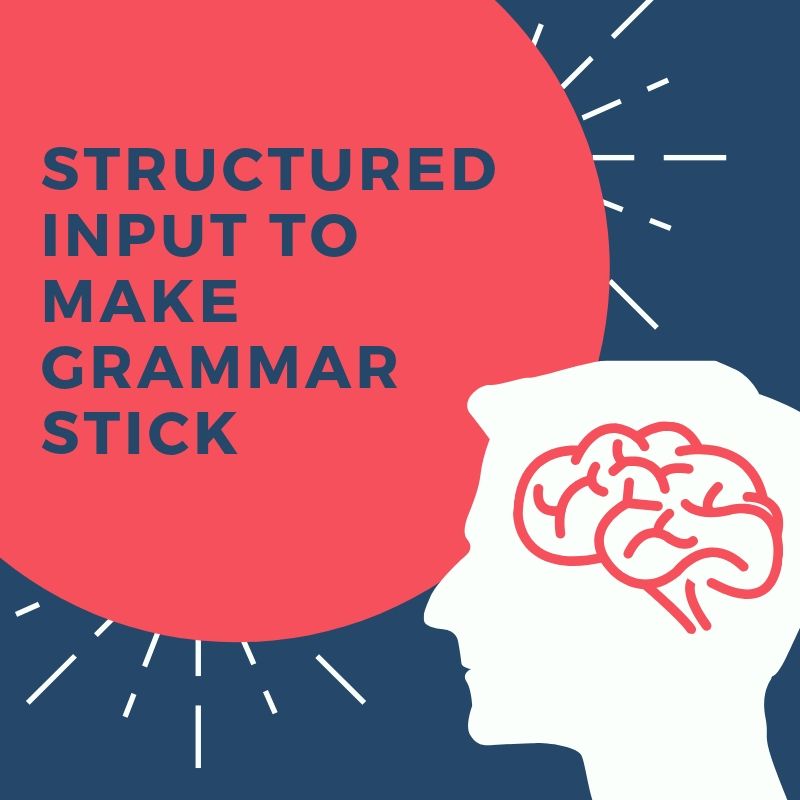
Structured Input to make grammar stick
Share
We both came from a learning environment where grammar and vocabulary were king, which certainly influenced how we began teaching second language. However, there is a plethora of research that shows that explicit grammar instruction is not the way to go. In fact, while there is a ton of research that says we should NOT teach grammar explicitly, there are few to non-existent findings that say we should.
So, how do you go about "teaching" structures for communication, if we know that input is what aids in acquisition but we want to teach for some semblance of accuracy? We talk about accuracy in other posts, so we won't get all SLA-y here. Instead, we'll tell you what we do love: communicative tasks that enhance structures and lead to acquisition <-- Trifecta, right there.
There are bunches of input methodologies, like Comprehensible Input, TPRS, the PACE model, and others others. All have the purpose of providing input to enhance acquisition. We find that our favored method, Structured Input, works best for us in the context of thematic teaching and authentic resources, plus provides the opportunity to make input relevant to our students, by including their interests and even their own life events.
Now for the gurus:
Lee and VanPatten define structured input as "input that is manipulated in particular ways to push learners to become dependent on form and structure to get meaning" (2003: 142).
GET MEANING. That's the most important part.
In other words, repeating the targeted structure in one activity multiple times, but designing it so that learners focus on meaning rather than grammatical accuracy (form) is what sets the stage for language to be acquired. Lee and VanPatten's guidelines for developing structured input activities include:
- Present one thing at a time.
- Focus primarily on meaning, not grammar.
- Move from sentences to connected discourse.
- Use both oral and written input.
- Have the learners do something with the input, through processing.
- Keep language acquisition and input processing in mind when designing.
Therefore, it's not just "slap some sentences on the page with [insert targeted grammar structure here] and it's acquired". It's well thought out, different and varied, and requires multiple steps so they can do something with the input.
In addition to creating exercises that are meaningful to students, Lee & VanPatten also stress the importance of exercises being truly communicative, in which the answer isn't known, and students have to attend to meaning to complete the activity. Keep in mind that "communicative" doesn't just refer to talking to someone else. A task is also communicative if the student has to process the meaning.
Think of it like this. If a student simply has to fill in a blank with a grammar form, they don't have to know (or care) what the rest of the sentence says. They have to evaluate what comes before the blank and use a strategy -- not communication -- to fill in the blank. On the other hand, if they have to rate, on a scale of 1-5 how much they agree that Ryan Gosling is more handsome than Ryan Reynolds, well, then they are communicating with that sentence. The answer can't be known, because, in this case, it's an opinion.
As we mentioned, each structured input activity will have multiple steps. We like to think of them as phases. The first phase is input centered. The second phase requires another level of interaction with the input. The last phase (sometimes with an additional phase) require that the students process their answers as compared to the class, the community or the world around them, hence "doing something" with the input and the communicative piece.
The primary focus in Structured Input becomes authentic language use and the development of communicative skills rather than the practice of grammatical structures. You'll find a number of Structured Input activities in your MesaMima units. Want a more personalized option? Check out this link!

1 comment
I couldn’t agree more. I love structured input since I became acquainted with this wonderful way for the students to become more proficient and acquire this part of language that can be tedious to study, understand or learn :)